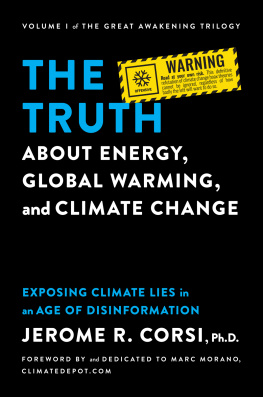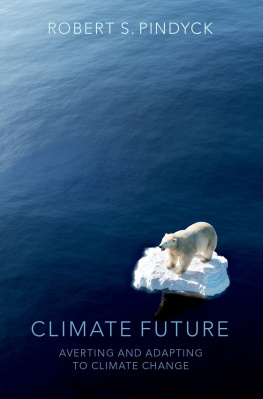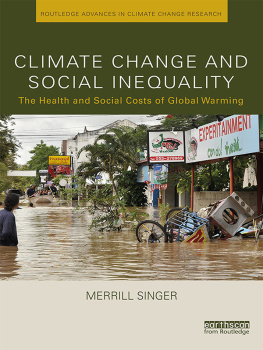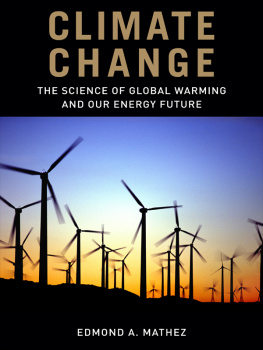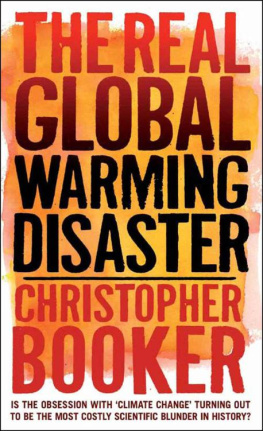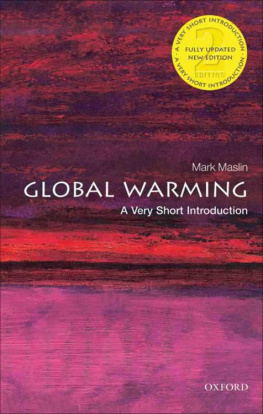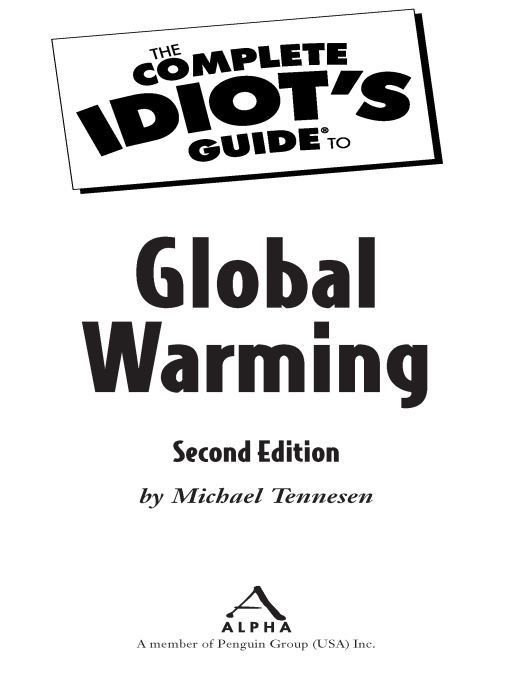Table of Contents
I dedicate this book to my wife, Maggie, and my mom, Annabelle. I couldnt have done it without you two.
Contents at a Glance
Part 1: Global Warming Signs 1
1 A Crisis in the Making 3 What are the problems now and in our future?
2 I Dont See Any Greenhouse 15 Learn about the chemicals that make up the greenhouse effect 15 and their role in the atmosphere.
3 Taking a Reading 27 What do ocean bottoms, tree rings, and polar ice tell us about 27 our future?
4 The Universe Is a Gas 39 Understand the delicate balance in our atmosphere and what 39 makes Earth more livable than Mars, Jupiter, or Venus.
Part 2: A Historical Perspective 49
5 Climate Is a Roller Coaster 51 Abrupt, long-term changes that the climate of the earth has 51 made in the last 12,000 years and the role of CO2.
6 More Recent Changes 61 Understand the major changes in climate during the time of 61 humankind.
7 The Dawn of the Industrial Age 73 Find out how the engines of commerce have changed the chemistry of the air.
8 Trees and Carbon Dioxide 85 Learn how cutting down the forests and plowing the grasslandshas altered the atmosphere on a vast scale.
Part 3: A Meteorological Primer 97
9 Weather 101 99 How does weather work, and how will global warming impact future hurricanes and tornadoes?
10 El Nio 111 Find out what another five or six degrees can do to our planet 111 and our lives.
11 Atmospheric Variables 123 Take a look at some of the variables that have influenced our 123 weather in the past and continue to do so today.
12 Ratcheting Up the Equation 135 Find out how deep ocean currents, permafrost, and melting polar ice has and will continue to drastically alter the climate.
Part 4: The Crystal Ball 147
13 The Global Picture 149 Discover how global warming has and will continue to affect Africa, Asia, Europe, Latin America, and island nations.
14 On the Home Front 161 Find out what global warming will do to commerce, agriculture,and health in North America.
15 Nature Coughs Up Her Share 173 Take a look at how global warming is wrecking wildlife, plants, and our national parks.
16 Whats in That Crystal Ball? 185 Understand how scientists use climate models that look at the past to predict the future.
Part 5: The Politics 197
17 A Protocol Known as Kyoto 199 Find out why trading smokestacks for rainforests is a small step in the right direction.
18 What If Its a Bunch of Bull? 209 Get the pros and cons of pollution reduction, energy conservation,and rainforest preservation.
19 Is That a Hole Up There? 221 How did politicians and scientists resolve the hole in the ozone, and what lessons can we apply to the current climate crisis?
20 Summing Up the Argument 233 Whos behind the predictions, what are they saying, and what is the current evidence?
Part 6: The Solution 245
21 It Starts with the Individual 247 Find out what you can do as an individual.
22 What About Transportation? 259 What are the environmental consequences of cheap gas, SUVs, and airplanes.
23 The Rainforest Is on Fire 271 What can we do besides slash-and-burn?
24 Running Out of Gas 285 The future looks bright for alternative energy.
Appendixes
A Glossary 299
B Further Reading 307
C Concerned Organizations 311 Index 315
Foreword
Lets be honest: were all idiots sometimes. You cruise through life minding your own business and suddenly everyones talking about tofu, or iPhones, or whether the napkingoes at the top of the place setting or tucked neatly under the fork on the left.
The topic that everyones talking about these days is global warming. Is it the greatesthoax ever perpetrated on the American people, as U.S. Senator James Inhofe said a few years ago? Or are we instead facing a global climate crisis, as former vice presidentand Nobel laureate Al Gore opined in a recent speech? This book will help you cut through such rhetoric using simple language and a clear treatment of the science.
Whatever youve heard, global warming isnt a hoax. Scientists have long known how greenhouse gases work. In 1827, physicist Jean Baptiste Fourier showed how carbon dioxide, methane, and other greenhouse gases trapped radiation to warm the earth. By the 1890s, chemist Svante Arrhenius (another Nobel laureate) described how emissionsfrom burning coal, oil, and other fossil fuels could warm the earth further.
Today, greenhouse gas concentrations are higher than at any time in the last million years, probably tens of millions. Atmospheric carbon dioxide has increased by a third since the start of the Industrial Revolution, and methane concentrations have more than doubled. How do we know this with certainty? Read Michael Tennesens book and find out.
We also know that the earth is warming quickly. We know this from weather stations, aircraft measurements, balloons, buoys, and boreholes. Pictures help, too. Satellite images show us that Arctic sea ice in 2007 shrank by 40 percent compared to a typicalsummer in the 1970s. Fifty years from now, you may be able to canoe to the north pole.
Couldnt natural causes, such as volcanoes or sunspots, be the culprits of warming? No, but dont take my word for it. Read the consensus statements from the U.S. National Academy of Sciences or the Intergovernmental Panel on Climate Change. Read the official statement of the 11,000-member American Meteorological Society: Because human activities are contributing to climate change, we have a collective responsibility to develop and undertake carefully considered response actions. Not if human activities are contributing to climate change, but because they are.
If global warming isnt a hoax, is it the global climate crisis that Al Gore refers to? Not yet, though if we dont act quickly it will be. This book is helpful because it also presents some practical solutions, such as like improving gas mileage in the cars we drive, or finding more abundant and cheaper sources of renewable energy. Did you realize that Henry Fords Model T got the same mileage as the U.S. fleet does todaya paltry 20 miles to the gallon? Or that Denmark now generates one fifth of all its electricity using wind power?
Tackling global warming makes environmental and economic sense. This book will show you why, while acknowledging some of the uncertainties that remain.
As the popular comic-strip character Dilbert likes to say, People are idiots. That observation may be true, but some of us are smart enough to know when to get help. Read all about global warming and make yourself one of the smartest idiots around.
Rob Jackson
Rob Jackson is the Nicholas Professor of Global Environmental Change at Duke University and founder and co-director of the Climate Change Policy Partnership. He has written several books about the environment, including The Earth Remains Forever, and a book of childrens poetry, Animal Mischief.
Introduction
A friend of mine called the other day. Like most of us, my friend is a concerned citizen.But he didnt want any long explanations. His questions were pointed: What is global warming? What is it going to do? Is it going to affect me in my lifetime?


